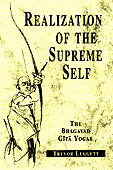 REALIZATION OF THE SUPREME SELF REALIZATION OF THE SUPREME SELF
Extract
"One evidence is that texts like the Gita present us with graded practical experiments. Do these, it says, and you can have direct experience of a God who is not simply your own idea. The experience is no illusion, because it is fruitful in life; it gives not only calm inner clarity, but also inspiration and energy for action. You will come to know the divine purpose in outline, and your own proper part in it in detail."
"In deep meditation one experiences how everything is dying: body, mind and every thought. But one can find something that does not die - the immortal in the mortal. And when death comes there is the awareness in the meditator: "I have been here before."
Synopsis
The Bhagavad Gita ('Sung By The Lord', about 500 BC) is a mystical section of the huge verse epic Mahabharata, and it is often called the Bible of India. Much of the religious instruction in the epic, like that of the still more ancient Vedas themselves, is concerned with how to worship and act so as to bring about rewards in the form of an ideal social order, individual prosperity, and a future in Heaven. The basis is devout action in faith. A few verses in the Gita refer to this 'trading' religion as it is called, and the whole Gita has been taken in this sense.
But India's greatest philosopher-yogin, S'ankara, wrote a famous commentary on the Gita, in which he showed that its purpose is quite different. The declared central purpose of the Gita is quite different. It shows the way to realize freedom from limitations of individuality, to confront, and finally become, the Cosmic Spirit in its manifesting and then in its transcendent form. The basis is experiment.
For instance, action is minutely analysed as creating restriction and suffering; it is shown how passion and sense of personal struggle distort action and make it inefficient. It becomes badly directed and has to be forced, creating outer friction; then the inner fears and hopes create inner friction. These experiments can be done in small way, and if they confirm what has been said, it seems reasonable that the deeper meditation experiments can be confirmed also. In activity, there is a much higher state where there is no sense of a personal 'I do'; cosmic energy expresses the cosmic purpose - the ultimate welfare of all beings.
Contents
Preface: Experimental Religion
PART I INTRODUCTORY
Bhagavad Gita
The Two Traditions
The Translation
The Setting
The Smile
Teaching Down
PART II YOGA-S OF THE GITA
Chapter II Supreme Self
III Yoga-s of the Self
Arjuna's Disbelief
IV Action
V Knowledge
The Thinker, East and West
VI Meditation
VII The Lord
VIII Yoga-power
IX & X Glories
XI Face to Face
XII Devotion
XIII The Field
XIV The Guna-s
XV One and Many
XVI Passion-struggle
Faith
XVII Worship, Gift, Austerity
XVIII Conclusion
PART III
S'amkara on Gita Practice
Reviews
The special merit of this book is that it points us firmly in the right direction. In our study of yoga we meet an almost infinite variety of doctrines, ideas and methods. The roads are many - how do we know when we are on the right path? The answer is clearly given in the ancient classics of India. As the Gita says, "When thy mind, which may be wavering in the contradictions of many scriptures, shall rest unshaken in divine contemplation then the goal of yoga is thine".
The Yoga Journal
This book is an excellent guide accessible to all. While highlighting the heart of the Gita text, the author by means of contemporary examples and illustrations helps to bridge the gap with the modern audience allowing the timeless message and guidance to shine clearly through. The book is aimed very much as a prompt for personal practice and experimentation: in essence the aim of Gita itself. A challenging and inspiring book, one to read and re-read and to use.
Yoga and Health
|
 REALIZATION OF THE SUPREME SELF
REALIZATION OF THE SUPREME SELF